There’s this misconception that businesses must get to a certain level before they’re ready for press. As if they need to be some big-shot executive or Fortune 500 company before anyone in press looks their way. Nope!
As someone who’s been on both sides of the publishing table for over a decade and has had her fair share of features in Business Insider, Lifehacker, and The New York Times, I can tell you that it’s never too early—or too late to get press.
You can get press today. I’ll show you how.
In this article, I’m going to share why press matters to you and your business. I’ll also share how businesses like yours can get press and maximize the potential of press to build trust, drive sales, drum up demand, and of course, skyrocket your authority and credibility—no matter what industry or niche you’re in, and even if it’s just one press feature.
Before we press on, I want to first tell you about this ramen—and how it relates to press.
Table of contents
The hidden benefits of press
This humble family-owned shop where this ramen is served seats no more than nine people at a time.
You can imagine that in Tokyo ramen shops such as this one are like grains of sand across a desert: they’re everywhere.
How do ramen shops compete when customers can pretty much walk 10 steps in any direction and run into one? Surely, in this saturated market this ramen shop would have a difficult time standing out?
…Well, actually…

Each day, without fail, this ramen shop has queues that form and rapidly expand before it even opens. The line snakes along the street and often needs to spill onto the other side!
How? Rather…WHY? Why are people willing to wait hours for a chance to eat at this ramen shop when they have so many other options around the corner, down the street, etc.
The answer is two words: Michelin Star.
Ohhh, it all makes sense now, doesn’t it?
For the majority of us foodies and mass consumers of good food, we understand exactly what it means for a restaurant to attain the coveted Michelin Star. Few restaurants, let alone ramen shops, get the distinction of a Michelin Star. It’s a prestigious label that quickly broadcasts to the world that this ramen is among the pantheon of outstanding, attention-worthy foods.
It tells existing customers that they’ve got great taste.
It tells new and curious customers that this ramen, not those other ones, is worth trying, even in spite of the long queues (which, by the way, beget even longer queues and more demand).
I call this the Michelin Star Effect, where a signal of quality, like the Michelin Star, dramatically boosts the credibility of your business, and that helps make choosing your business over the competition a no-brainer.
So…what does this mean for you?
You’re not a ramen shop (probably), and getting a Michelin Star likely isn’t going to drive people to your digital products and marketing services. But the point is, you can harness the Michelin Star Effect for your own business. This is one example how:
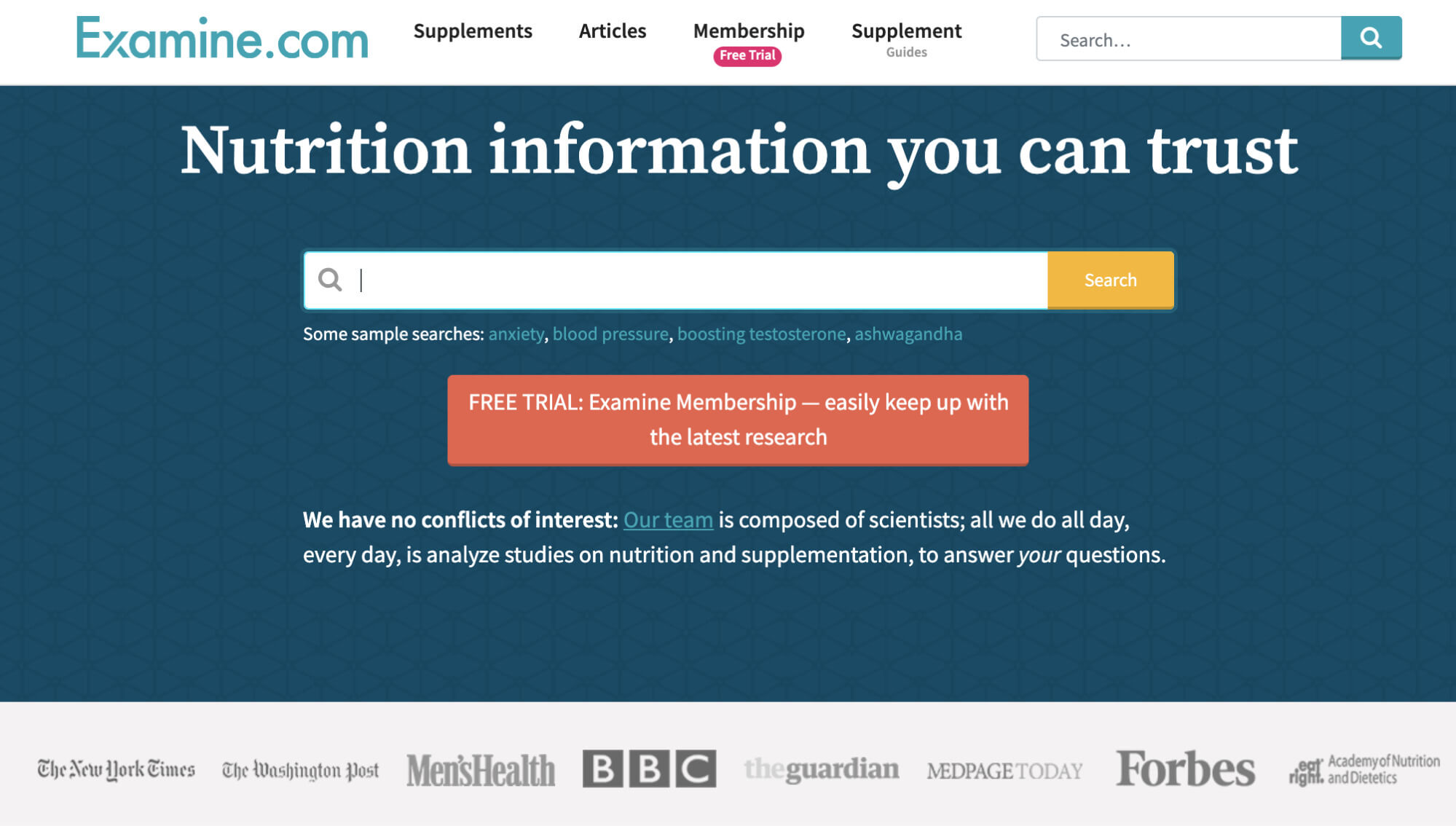
Notice the press—the publication’s logos just below the fold.
What do those logos tell you?
First of all, they tell me this business is newsworthy enough to be featured by many members of the press. In Examine’s case, they claim to have “nutrition information I can trust.” If The New York Times has vetted them for that, then there’s some truth to it, right? (Sure enough, they’re also trusted by the Academy of Nutrition and Dietetics, which is another major authority in the realm of nutrition information.)
It’s important to remember that press only cares about interesting stories and vets all of its sources. Not just anyone can be written about. When the gatekeepers of the media, AKA editors, decide to write about a business, it’s because they think they’re worth talking about with the masses. These editors are willing to stake their reputation on them. That in itself is a big ol’ badge of recognition you can share with customers.
When you get published somewhere, you can leverage the publication’s logos and display them in strategic areas of your business to convey credibility. I often recommend that my clients place between 3 to 5 logos at all possible customer touch points, including your key sign-up pages:

Or prospective customer sales emails like this:

Or even on ads to enhance social media marketing efforts, like this company:

When customers are more discerning than ever, logos like these show customers that you’ve already been vetted—a quick signal of trust.
Think of Michelin Stars or even those Zagat Rated and Trip Advisor decals that adorn a restaurant’s doors. Wouldn’t you be more curious to give that restaurant a try versus one that didn’t have those signals? These logos serve the same purpose.
Depending on your niche and industry, certain press and features carry a lot more clout than others. Press is strategic. In my own case, where I help other businesses build authority and get press, the sheer number goes a long way in conveying my own credibility:
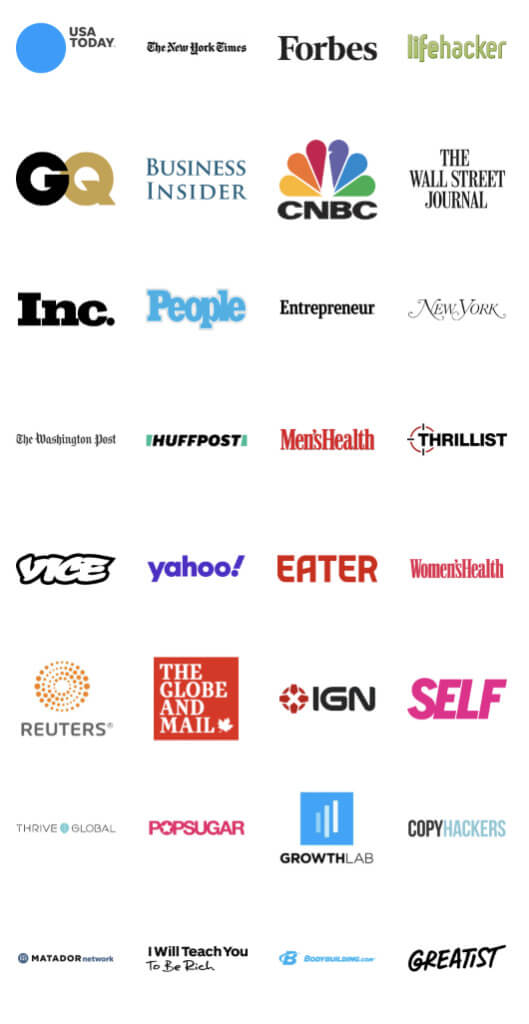
Notice that press now isn’t just about traffic or exposure—two very common misconceptions about the benefits of press.
YES, you’ll get traffic.
YES, you’ll get exposure.
But those miss the point. The most valuable benefit of press is a one-two punch combo of elevating the public perception of your brand and boosting your authoritative value on Google. Observe this Tweet from Google’s own John Mueller:

In other words, digital press will only help your SEO efforts and help you rank better on Google search (even for a site with no traffic, according to John).
Oh, and one more thing: There is no “Best by” date. You can leverage the press you get for years and years, long after the initial publication date of those articles.
No matter what stage of business you’re in, it’s never too early—or too late—to get press. And whether it’s your first or seventh logo, I’m now going to share the exact idea-generating framework I use to come up with client stories and catapult them into the media limelight.
A 3-part framework to generating ideas the media loves
A lot of clients come to me right before they have something to launch, whether they have a new product, feature, book, online course, or life lesson they’re excited for everyone to know. You can get press for all of these things, but the most important thing to consider is:
What’s your story?
These are the things editors and the press care about. They care less about the fact that you generated $40,034 from a single launch of a $4.99 ebook.
But if you’d said you did it in two days with the help of your celebrity friend LeBron James and all the proceeds were going to charity to help build homes for all those koalas displaced by forest fires—well, suddenly that is a lot more mouth-watering.
The media is always, always on the lookout for good stories and ideas—and oftentimes it’s highly predictable what they want. In fact, I broke it down in a 3-part framework that I call Pitch Like a PRO.
The Pitch Like a PRO framework
Basically, is your idea PRO? Is it…
- Popular?
- Relevant?
- Original?
Sure, when it’s written out like this, the framework doesn’t reveal any sort of media wizardry. But I believe that mastery of media lies in a deep understanding of its simplicity. I’m going to get into very specific details of each and show you how to:
- Find popular ideas before they become saturated;
- Use relevant ideas to piggyback off what’s happening in the news cycle;
- Make virtually any idea original.
Plus, this framework will be useful to you not just for upcoming launches — but also for any idea, any time.
1. How to find popular ideas… before other people do
There are certain topics that will, for whatever reason, stay top of mind in our society’s collective conscience, such as full-body workouts and a morning routine (and their variants):


Topics like weight loss and dating are popular because people constantly search for and talk about them—for all eternity. And sometimes in a weird “chicken-or-egg” cycle it’s the media that jumpstarts an idea’s popularity.
But outside the realm of these perennial favorites, there are ways to find out if an idea is popular—or getting there (just before the media sinks their teeth into it).
So how exactly do you systematically check for a topic’s popularity? The easiest place to start is Google.

If you Google your topic and see the other articles that already exist on it, GREAT! Click around and notice details like:
- How many people are talking about it? (Check the number of comments.) The more people are talking about it, the better.
- How recent are the articles? (Check the publication date.) If it’s recent, it’s top of mind.
- Have other publications written about it? (News outlets all have a finely tuned radar for finding out what’s popular — and they’ll often “copy” one another.)
- How many times has it been shared? (If a lot of people are sharing, the idea is clearly resonating enough and they feel compelled to tell their friends.)
Essentially, what’s popular will attract more readers. Editors are always scouting for the next big hit. After all, an editor’s metric for popularity (and ultimately success) is: how many eyeballs will it bring to their article and site?
You can also use Google Insights to check the trends of a topic. In other words, you get to see how many people are searching. Let’s say you were in the health and fitness industry, and you have a unique full-body workout program coming out. You can check the peaks and valleys of search popularity here:
Then you can scroll down and find exactly what queries are getting the most hits on Google and hone in on an idea for the media.
This already gives me several angles. As a simple example, I might explore the idea of pitching “Can full body workouts at home be a good replacement for the gym?”
The goal here is to find an angle on an already ongoing popular conversation and add your fresh take.
2. How to use relevance to snowball one article into several
Something that’s relevant is newsworthy and timely. Unlike something that is popular (although an idea can be relevant and popular), relevance can fade in and out of obscurity. Let me show you an example of a relevant, newsy headline:

The headline is so bombastic, catchy, and jarring that other publications will follow suit and report on the same thread, or go on the counter-attack:

Regardless of their stance, this conversation is now entrenched in the newscycle, and it’s a conversation that editors want to continue to stoke—at least until the next one.
So if something is relevant, chances are good that the editor WANTS your idea right then and there. Here’s how Examine, an independent nutrition company, rode relevance into the media limelight, including getting featured in The New York Times.
Early in 2020, the media got bludgeoned with a ton of misinformation about vitamins and their protective effects. Many sleazy marketers preyed on the vulnerability of people at this time to hawk supplements and “cures” with flimsy evidence of their efficacy. So it became relevant to educate the masses.
Examine’s team of researchers put together an evidence-based user guide to help the average person make heads or tails of all the information out there.

The benefits of this are two-fold: It’s a trusted resource for the user, and a one-stop information shop for journalists, including one at the The New York Times.
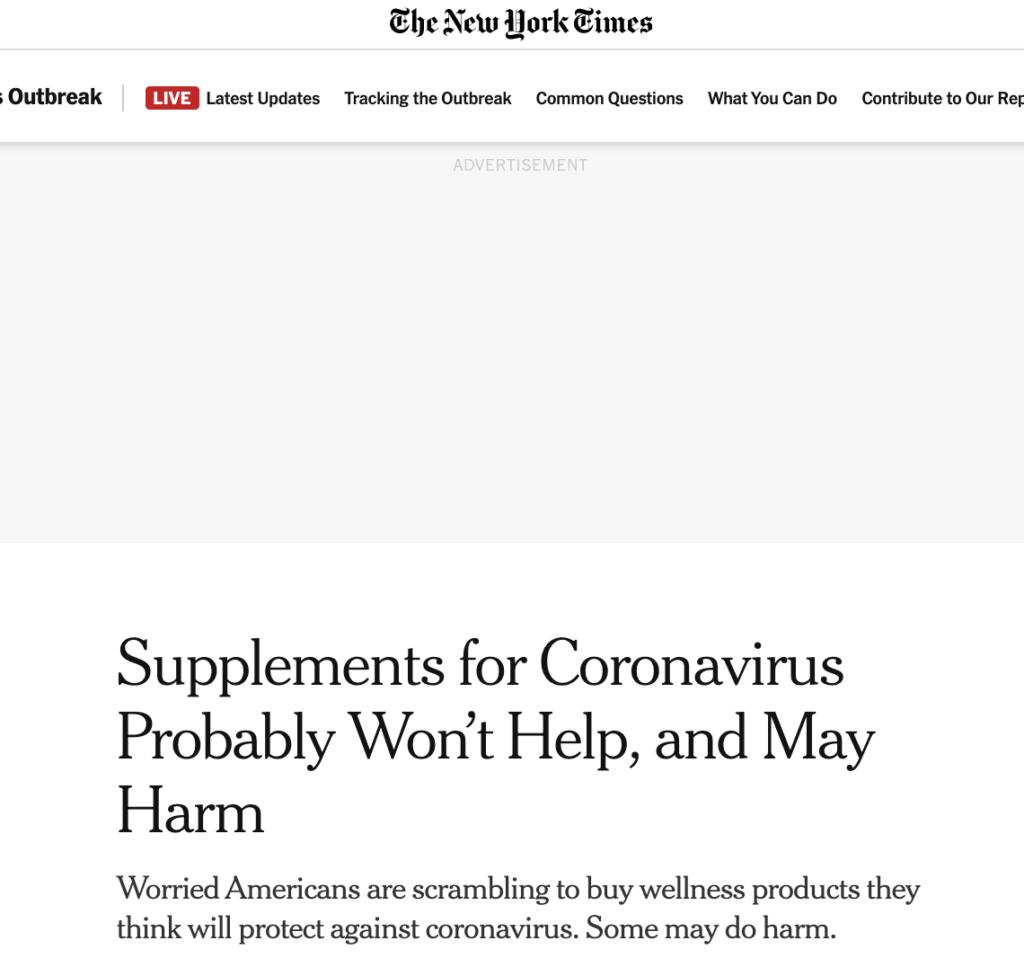
Because of the perfect storm of Examine’s reputation and the media’s need for truth, The New York Times published this piece that further propelled Examine onto other news sources:


As you can see, one helpful user guide snowballed into several features in the media because it was timely and relevant in the news cycle. But most of all, it was valuable.
The big insight here: Focus on what’s happening in the world and find a relevant thread in your life or business. In other words, how can you add value to the current conversation?
3. How to make any idea original
Over the span of a few years, I lived in seven different countries, working remotely and being a quasi-local and tourist at over a dozen destinations, like Tokyo, Hong Kong, Singapore, London, Paris, Barcelona, and so on.
Stories of travel are nothing new. Certainly, being a digital nomad at the time has been written about before. But here I am, sharing my experiences of working remotely around the world on Lifehacker:
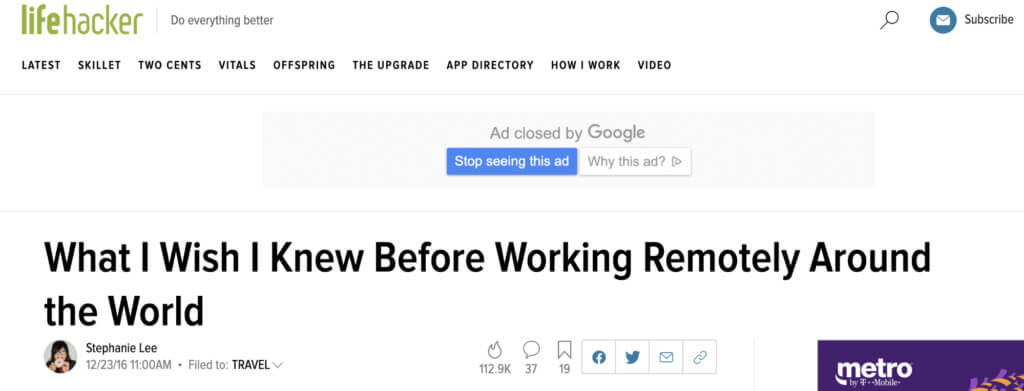
…on an entrepreneur site GrowthLab:

And again on Business Insider:

This is the power of having your own story to tell and putting multiple interesting spins on them. There’s always another angle. Another part of the story to unravel.
Think about all the first-person stories you see:
- “This Is How I Lost 58 Pounds and I Didn’t Even Exercise!”
- “I Started Drinking 10 Cups of Coffee Per Day and Tripled My Income in 6 Months”
- “Why I Give My Corgi Daily Massages”
The key insight here is that, while traveling to different countries and being a digital nomad isn’t anything new, I drew from my own experiences and gave these common topics a unique spin.
Because I’d been featured in a half dozen other places on the same experience, even The New York Times reached out to me for this story:
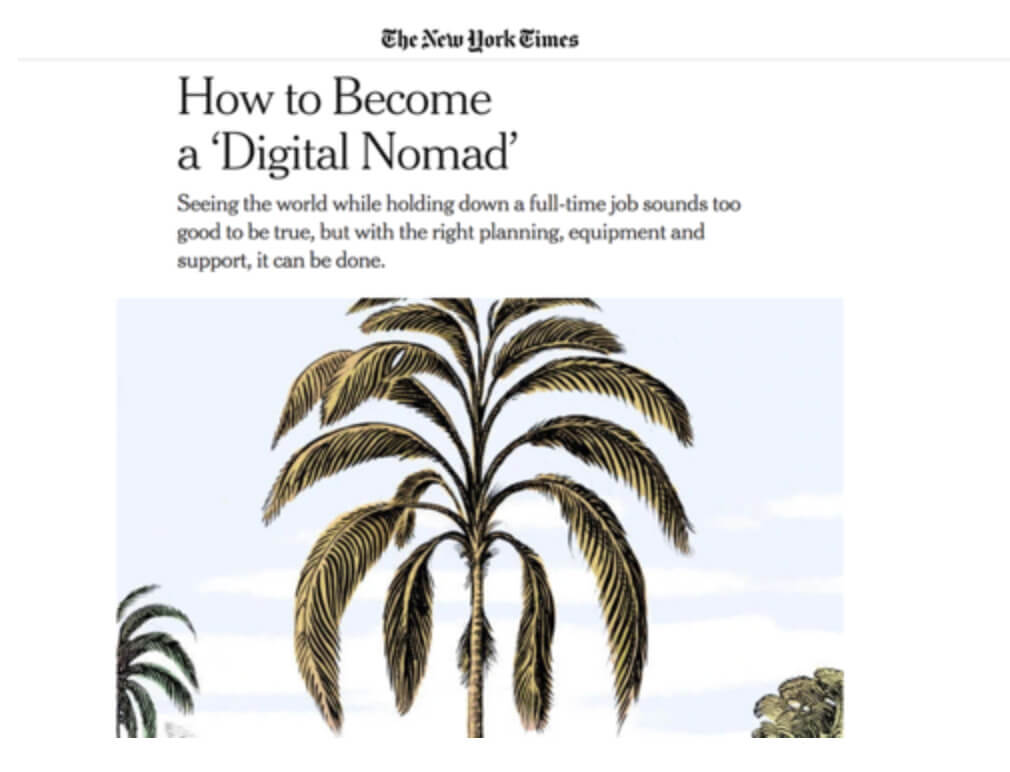
These are the types of stories editors are happy to publish. Any time you have an article idea and use your story, it almost guarantees a unique take on the same otherwise well-trodden topic. Most important of all, it’s a story that only you can tell. And yes, you can tie it back to your business.
Here’s an example from a client:

As long as you have an experience with a strong point of view to share, you should tell it—and the media would be happy to have it.
Conclusion
The media is always looking for stories and businesses like yours. What they look for in a story is fairly predictable. Using the Pitch Like a PRO framework, you can come up with popular, relevant, or original ideas so that your stories become so irresistible that the media cannot help but want to cover you.
Here’s a quick recap with real, example headlines:
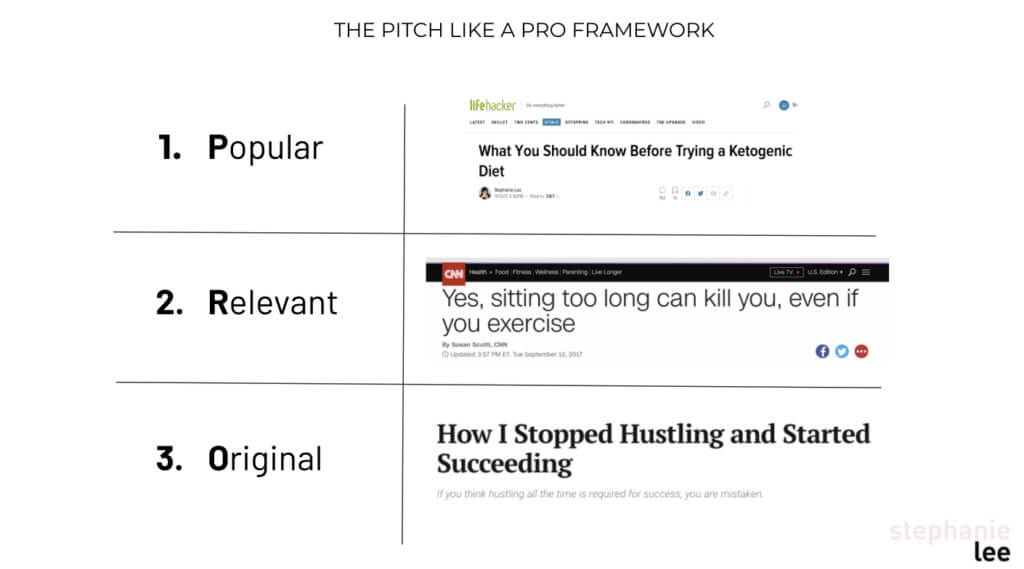
Press is another form of social proof to enhance your SEO, lead generation, and marketing efforts and help elevate your business.
Whether this is your first or even eighth feature, you can leverage press (and their logos) to generate more press, build more authority, and open up the opportunities that come with greater authority and credibility (like book deals, speaking gigs, etc.)—for years and years to come.

